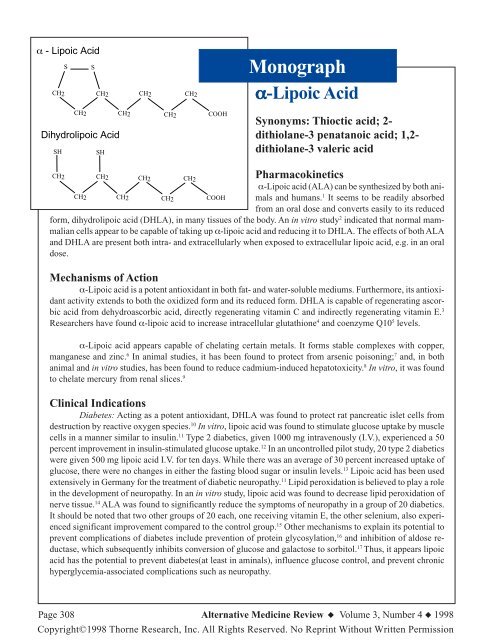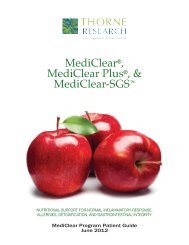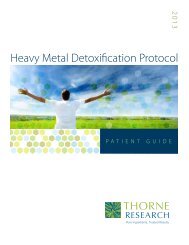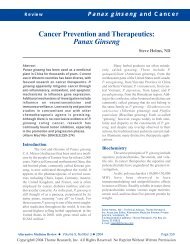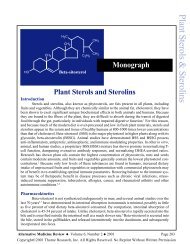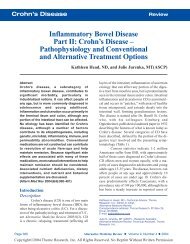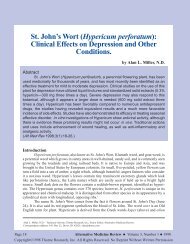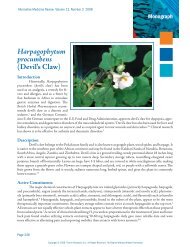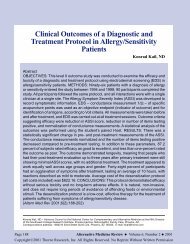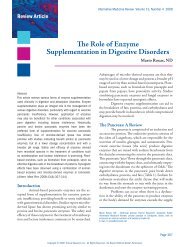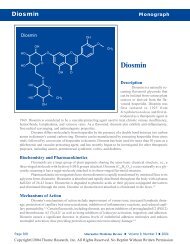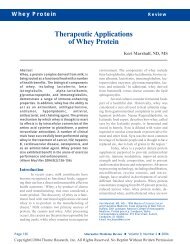Monograph - Alternative Medicine Review
Monograph - Alternative Medicine Review
Monograph - Alternative Medicine Review
You also want an ePaper? Increase the reach of your titles
YUMPU automatically turns print PDFs into web optimized ePapers that Google loves.
α - Lipoic AcidS SCH2 CH2 CH2CH2<strong>Monograph</strong>α-Lipoic AcidCH2 CH2 CH2Dihydrolipoic AcidSHSHCOOHSynonyms: Thioctic acid; 2-dithiolane-3 penatanoic acid; 1,2-dithiolane-3 valeric acidCH2CH2CH2CH2 CH2 CH2CH2COOHPharmacokineticsα-Lipoic acid (ALA) can be synthesized by both animalsand humans. 1 It seems to be readily absorbedfrom an oral dose and converts easily to its reducedform, dihydrolipoic acid (DHLA), in many tissues of the body. An in vitro study 2 indicated that normal mammaliancells appear to be capable of taking up α-lipoic acid and reducing it to DHLA. The effects of both ALAand DHLA are present both intra- and extracellularly when exposed to extracellular lipoic acid, e.g. in an oraldose.Mechanisms of Actionα-Lipoic acid is a potent antioxidant in both fat- and water-soluble mediums. Furthermore, its antioxidantactivity extends to both the oxidized form and its reduced form. DHLA is capable of regenerating ascorbicacid from dehydroascorbic acid, directly regenerating vitamin C and indirectly regenerating vitamin E. 3Researchers have found α-lipoic acid to increase intracellular glutathione 4 and coenzyme Q10 5 levels.α-Lipoic acid appears capable of chelating certain metals. It forms stable complexes with copper,manganese and zinc. 6 In animal studies, it has been found to protect from arsenic poisoning; 7 and, in bothanimal and in vitro studies, has been found to reduce cadmium-induced hepatotoxicity. 8 In vitro, it was foundto chelate mercury from renal slices. 9Clinical IndicationsDiabetes: Acting as a potent antioxidant, DHLA was found to protect rat pancreatic islet cells fromdestruction by reactive oxygen species. 10 In vitro, lipoic acid was found to stimulate glucose uptake by musclecells in a manner similar to insulin. 11 Type 2 diabetics, given 1000 mg intravenously (I.V.), experienced a 50percent improvement in insulin-stimulated glucose uptake. 12 In an uncontrolled pilot study, 20 type 2 diabeticswere given 500 mg lipoic acid I.V. for ten days. While there was an average of 30 percent increased uptake ofglucose, there were no changes in either the fasting blood sugar or insulin levels. 13 Lipoic acid has been usedextensively in Germany for the treatment of diabetic neuropathy. 11 Lipid peroxidation is believed to play a rolein the development of neuropathy. In an in vitro study, lipoic acid was found to decrease lipid peroxidation ofnerve tissue. 14 ALA was found to significantly reduce the symptoms of neuropathy in a group of 20 diabetics.It should be noted that two other groups of 20 each, one receiving vitamin E, the other selenium, also experiencedsignificant improvement compared to the control group. 15 Other mechanisms to explain its potential toprevent complications of diabetes include prevention of protein glycosylation, 16 and inhibition of aldose reductase,which subsequently inhibits conversion of glucose and galactose to sorbitol. 17 Thus, it appears lipoicacid has the potential to prevent diabetes(at least in aminals), influence glucose control, and prevent chronichyperglycemia-associated complications such as neuropathy.Page 308 <strong>Alternative</strong> <strong>Medicine</strong> <strong>Review</strong> ◆ Volume 3, Number 4 ◆ 1998Copyright©1998 Thorne Research, Inc. All Rights Reserved. No Reprint Without Written Permission
α - Lipoic AcidCataracts: The enzyme, aldose reductase, plays an important role in the development of cataracts indiabetes. α-Lipoic acid was found to inhibit aldose reductase activity in the rat lens; 17 and, in further animalstudies, was found to inhibit cataract formation experimentally induced by buthionine sulfoxamine. 18Glaucoma: Lipoic acid, at dosages of either 75 mg daily for two months or 150 mg daily for onemonth, was administered to 75 subjects with open-angle glaucoma. Thirty-one others served as controls andwere given only local hypotensive therapy. The greatest improvements in both biochemical parameters ofglaucoma and visual function were seen in the group receiving 150 mg lipoic acid. 19Ischemia-Reperfusion Injury: After an area has been deprived of blood for a period of time, such asoccurs in the brain after a stroke or in cardiac tissue after clot dissolution, reperfusion of the tissues causes aburst of free radical formation. Several animal studies have demonstrated the effectiveness of DHLA in theprevention of reperfusion injury. 20-24Amanita mushroom poisoning: α-Lipoic acid infusions were used in the treatment of amanita mushroompoisoning in 75 patients between 1974 and 1978. While 10-50 percent of patients recover without intervention,89 percent (67 of 75) recovered after lipoic acid infusion. 25Alcoholic Liver Disease: Although preliminary studies have indicated possible benefit of lipoic acidin the treatment of alcoholic liver disease, the only controlled, double-blind, study found ALA had no significantinfluence on the course of the disease. 26Other possible effects: Other potential therapeutic uses for ALA or DHLA include: protection fromradiation injury, prevention of neurological disorders by preventing oxidative damage of the central nervoussystem, 27 prevention of HIV viral replication by inhibition of reverse transcriptase, 28 protection from the effectsof cigarette smoke, and treatment of heavy metal toxicity. 27 These are interesting theoretical considerationsrequiring further research.DosageRecommended therapeutic dosage of α-lipoic acid is in the range of 300-600 mg/day taken orally.Safety, Toxicity and Side Effectsα-Lipoic acid appears to be safe in the dosages generally prescribed clinically. The LD 50was 400-500mg/kg after an oral dosage in dogs. 27 However, lower dosages (20 mg/kg) given intraperitoneally to severelythiamin-deficient rats proved fatal. These adverse effects were prevented when thiamin was administered withthe lipoic acid. 29 There have not been sufficient studies to guarantee safety for its use in pregnancy. Allergicskin conditions are among the few reported side effects of lipoic acid administration in humans.References1. Carreau JP. Biosynthesis of lipoic acid via unsaturated fatty acids. Methods Enzymol 1979;62:152-158.2. Handelman GJ, Han D, Tritschler H, Packer L. α-Lipoic acid reduction by mammalian cells to the dithiol form andrelease into the culture medium. Biochem Pharmacol 1994;47:1725-1730.3. Scholich H, Murphy ME, Sies H. Antioxidant activity of dihydrolipoate against microsomal lipid peroxidation and itsdependence on α-tocopherol. Biochem Biophys Acta 1989;1001:256-261.4. Busse E, Zimmer G, Schopohl B, et al. Influence of alpha-lipoic acid on intracellular glutathione in vitro and in vivo.Arzneimittel-Forschung 1992;42:829-831.<strong>Alternative</strong> <strong>Medicine</strong> <strong>Review</strong> ◆ Volume 3, Number 4 ◆ 1998 Page 309Copyright©1998 Thorne Research, Inc. All Rights Reserved. No Reprint Without Written Permission
5. Kagan V, Serbinova E, Packer L. Antioxidant effects of ubiquinones in microsomes and mitochondria are mediated bytocopherol recycling. Biochem Biophys Res Comm 1990;169:851-857.6. Sigel H, Prijs B, McCormick DB, Shih JCH. Stability of binary and ternary complexes of a-lipoate and lipoate derivativeswith Mn 2+ , Cu 2+ , and Zn 2+ in solution. Arch Biochem Biophys 1978;187:208-214.7. Grunert RR. The effect of DL α-lipoic acid on heavy-metal intoxication in mice and dogs. Arch Biochem Biophys1960;86:190-194.8. Muller L, Menzel H. Studies on the efficacy of lipoate and dihydrolipoate in the alteration of cadmium toxicity in isolatedhepatocytes. Biochem Biophys Acta 1990;1052:386-391.9. Keith RL, Setiarahardjo I, Fernando Q, et al. Utilization of renal slices to evaluate the efficacy of chelating agents forremoving mercury from the kidney. Toxicology 1997;116:67-75.10. Heller B, Burkhart V, Lampeter E, Kolb H. Antioxidant therapy for the prevention of type 1 diabetes. Adv Pharm1997;38:629-638.11. Estrada DE, Ewart HS, Tsakiridis T, et al. Stimulation of glucose uptake by the natural coenzyme alpha-lipoic acid/thioctic acid: participation of elements of the insulin signaling pathway. Diabetes 1996;45:1798-1804.12. Jacob S, Henriksen EJ, Schiemann AL, et al. Enhancement of glucose disposal in patients with type 2 diabetes by alphalipoicacid. Arzneimittel-Forschung 1995;45:872-874.13. Jacob S, Henriksen EJ, Tritschler HJ, et al. Improvement of insulin-stimulated glucose-disposal in type 2 diabetes afterrepeated parenteral administration of thioctic acid. Exp Clin Endocrinol Diabetes 1996;104:284-288.14. Nickander KK, McPhee BR, Low PA, Tritschler H. Alpha-lipoic acid: antioxidant potency against lipid peroxidation ofneural tissues in vitro and implications for diabetic neuropathy. Free Radic Biol Med 1996;21:631-639.15. Kahler W, Kuklinski B, Ruhlmann C, Plotz C. Diabetes mellitus—a free radical-associated disease. Results of adjuvantantioxidant supplementation. Z Gesamte Inn Med 1993;48:223-232.16. Schleicher ED, Wagner E, Nerlich AG. Increased accumulation of the glycoxidation product N(epsilon)-(carboxymethyl)lysine in human tissues in diabetes and aging. J Clin Invest 1997;99:457-468.17. Ou P, Nourooz-Zadeh J, Tritschler HJ, Wolff S. Activation of aldose reductase in rat lens and metal-ion chelation byaldose reductase inhibitors and lipoic acid. Free Radic Res 1996;25:337-346.18. Reider HP, Berger W, Fridrich R. Vitamin status in diabetic neuropathy (thiamine, riboflavin, pyridoxine, cobalamin andtocopherol). Z Ernahrungswiss 1980;19:1-13.19. Filina AA, Davydova NG, Endrikhovskii SN, et al. Lipoic acid as a means of metabolic therapy of open-angle glaucoma.Vestn Oftalmol 1995;111:6-8.20. Scheer B, Zimmer G. Dihydrolipoic acid prevents hypoxic/reoxygenation and peroxidative damage in rat mitochondria.Arch Biochem Biophys 1993;302:385-390.21. Assadnazari H, Zimmer G, Freisleben HJ, et al. Cardioprotective efficiency of dihydrolipoic acid in working rat heartsduring hypoxia and reoxygenation. P nuclear magnetic resonance investigations. Arzneimittel-Forschung 1993;43:425-432.22. Prehn JH, Karkoutly C, Nuglisch J, et al. Dihydrolipoate reduces neuronal injury after cerebral ischemia. J Cereb BloodFlow Metab 1992;12:78-87.23. Panigrahi M, Sadguna Y, Shivakumar BR, et al. alpha-Lipoic acid protects against reperfusion injury following cerebralischemia in rats. Brain Res 1996;717:184-188.24. Cao X, Phillis JW. The free radical scavenger, alpha-lipoic acid, protects against cerebral ischemia-reperfusion injury ingerbils. Free Rad Res 1995;23:365-370.25. Haramaki N, Assadnazari H, Zimmer G, et al. The influence of vitamin E and dihydrolipoic acid on cardiac energy andglutathione status under hypoxia-reoxygenation. Biochem Mol Biol Int 1995;37:591-597.26. Marshall AW, Graul RS, Morgan MY, Sherlock S. Treatment of alcohol-related liver disease with thioctic acid: A sixmonth randomised double-blind trial. Gut 1982;23:1088-1093.27. Packer L, Witt E, Tritschler HJ. alpha-Lipoic acid as a biological antioxidant. Free Radic Biol Med 1995;19:227-250.28. Baur A, Harrer T, Peukert M, et al. Alpha-lipoic acid is an effective inhibitor of human immuno-deficiency virus (HIV-1)replication. Klin Wochenschr 1991;69:722-724.29. Gal EM. Reversal of selective toxicity of (-)-α-lipoic acid by thiamine in thiamine-deficient rats. Nature 1965;205:535.Page 310 <strong>Alternative</strong> <strong>Medicine</strong> <strong>Review</strong> ◆ Volume 3, Number 4 ◆ 1998Copyright©1998 Thorne Research, Inc. All Rights Reserved. No Reprint Without Written Permission
AbstractsRecently Published AbstractsProstate cancer andsupplementation withalpha-tocopherol and betacarotene:incidence andmortality in a controlledtrial.Heinonen OP, Albanes D,Virtamo J, et al. J NatlCancer Inst 1998;90:440-446.BACKGROUND: Epidemiologic studies have suggested thatvitamin E and beta-carotene may each influence the developmentof prostate cancer. In the Alpha-Tocopherol, Beta-CaroteneCancer Prevention Study, a controlled trial, we studied the effectof alpha-tocopherol (a form of vitamin E) and beta-carotenesupplementation, separately or together, on prostate cancer inmale smokers. METHODS: A total of 29133 male smokers aged50-69 years from southwestern Finland were randomly assignedto receive alpha-tocopherol (50 mg), beta-carotene (20 mg), bothagents, or placebo daily for 5-8 years (median, 6.1 years). Thesupplementation effects were estimated by a proportional hazardsmodel, and two-sided P values were calculated. RESULTS: Wefound 246 new cases of and 62 deaths from prostate cancerduring the follow-up period. A 32% decrease (95% confidenceinterval [CI] = -47% to -12%) in the incidence of prostate cancerwas observed among the subjects receiving alpha-tocopherol (n =14564) compared with those not receiving it (n = 14569). Thereduction was evident in clinical prostate cancer but not in latentcancer. Mortality from prostate cancer was 41% lower (95% CI =-65% to -1%) among men receiving alpha-tocopherol. Amongsubjects receiving beta-carotene (n = 14560), prostate cancerincidence was 23% higher (95% CI = -4%-59%) and mortalitywas 15% higher (95% CI = -30%-89%) compared with those notreceiving it (n = 14573). Neither agent had any effect on the timeinterval between diagnosis and death. CONCLUSIONS: Longtermsupplementation with alpha-tocopherol substantially reducedprostate cancer incidence and mortality in male smokers.Other controlled trials are required to confirm the findings.<strong>Alternative</strong> <strong>Medicine</strong> <strong>Review</strong> ◆ Volume 3, Number 4 ◆ 1998 Page 311Copyright©1998 Thorne Research, Inc. All Rights Reserved. No Reprint Without Written Permission


